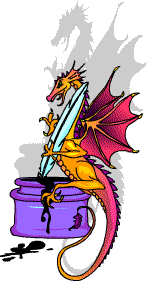Dungeons and Dragons Weapons
Created | Updated Sep 2, 2002
If you want Items click on the coloured writing.
 Dungeons and Dragons club
Dungeons and Dragons clubKnives
all knives cost 40 gold
is one design of particular interest. The blade is perpendicular to the handle, and the weapon is gripped like a corkscrew to reveal the double-edged and generally triangular blade.
is often used by fencers, is a short, triangle-shaped dagger used in the off hand (that is, whichever hand isn't using the sword). It is rarely used to attack, but is used to parry the opponent's sword while keeping one's own blade ready to strike
is held backwards. Instead of the blade protruding forward toward the victim, the knife is held in such a way that the blade goes down the outside of the user's forearm.
Swords
all swords are 50 gold
is stereotypical. Three or four feet long with a straight, double-edged blade and a cross-hilt, it occasionally has a pointed end for stabbing.
is also fairly standard, about a foot and a half to two and a half feet long but otherwise very similar to the broadsword.
is a Celtic style of sword. It resembles a broadsword with one major exception: it's big. Very, very big. Often as tall as the person wielding it, the Claymore is used two-handed and rarely, if ever, to parry an opponent's strike. A swordsman using a Claymore will seek to strike first and hardest.
is a heavy, slightly curved sword, often carried as a sidearm by the military.
is a heavy curved Chinese sword. Its name, appropriately, means 'cutter'.
A thrusting sword features a point rather than a blade, the intention being to impale rather than to chop or cut the target. They are commonly used by fencers in the French or Italian style.
is short, light, and somewhat flexible. Often issued to the European military and a favourite of 'gentlemen', there is also a dress version that is shorter, lighter, and often more ornate; it was used as a fashion accessory more than a weapon. Those opting for disguise sometimes concealed one in a cane.
was issued to all Roman legionnaires. While it has an edge, it is designed for thrusting,
Slicing swords are razor-sharp, and instead of simply hacking away at the target, the edge of the blade must be drawn across the flesh, often cutting very deeply. There is some rivalry concerning whether chopping or slicing swords are better, but it is unlikely that members of either school would wish to be attacked with either one.
was the bane of the Crusaders in the Crusade Wars. It has a wide, curved, single-edged blade. These are used both from horseback and on foot.
is the familiar Japanese Samurai sword, featuring a long, curved blade. The symbol of the Samurai class were the Katana and wakisashi - the wakisashi being, more or less, a shorter Katana. These versatile swords can be used either one- or two-handed alone, or as a set with one in each hand.
is to Katanas what the Claymore is to the Broadsword.
is not a slicing sword; it's a wooden katana and mostly used for training. It was also a favourite of the legendary ronin4 Miyamoto Musashi. A bokken is thick and heavy and nearly as dangerous as the katana itself. Many schools abandoned the Bokken in favour of the Shinai, which is similar in length, weight, and balance to the katana, but is fashioned of bamboo strips wrapped in cloth, so it is much less dangerous to aspiring swordsmen.
is essentially a katana intended to be used from horseback.
were often utilized by the Ninja in Japan, as the second name implies. It is much like a katana, but is straight and has a shorter blade. Always resourceful, the Ninja often crafted the scabbard for use as a blowpipe and then concealed the whole thing inside a staff.
is a Korean sword, revered in a similar way to the Japanese katana. It can be either straight and double-edged or curved and single-edged. Traditionally, the quality of Japanese and Korean swords was very high, and swordsmith was a well-respected position.
is creative in design and has a name that is near unpronounceable. It is made nearly entirely out of pieces of wood glued together; the edge being provided by pieces of obsidian between the planks. Rarely, if ever, was there a point for thrusting. These swords, being made of wood and glass, were very fragile and required frequent repairs, even if used to cut nothing but cloth and flesh.
Spears
all spears 55
is among the simplest of spears which include the Japanese Yari and Rochin, and the Roman Hasta. These are simply shafts and impaling points, used to impale the target.
is a rather nasty variation around the general theme of 'spear'. The head is covered in backward-pointing barbs and spikes. In use, the spear is aimed at the vital organs not protected by a skull or rib cage, pushed in as far as it will go, and pulled out again. The barbs often tear a few vital organs on the way out, too.
pick a weapon wirte here to get it
